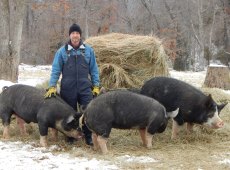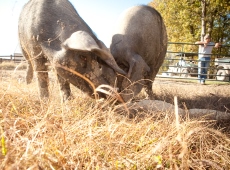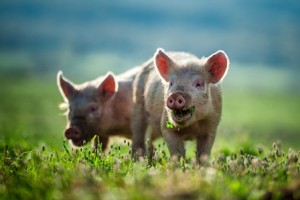Feeding Pigs
 We promote outdoor pig production, integration with crops and the use of home-grown as well as forage-based diets for pigs. There are important challenges when developing feeding systems for these conditions, including balancing the supply and requirements of essential amino acids without relying too much on external feedstuffs and developing and implementing nutritional concepts which help to improve animal health status (Zollitsch, 2007). The energy requirement of pigs kept outdoors is increased as a result of greater exercise and the process of maintaining body temperature. Under Northern European conditions this is typically by about 15% higher than sows kept indoors (Edwards, 2003). There are also environmental issues to consider, particularly with regard to diffuse pollution and run-off of nutrients.
We promote outdoor pig production, integration with crops and the use of home-grown as well as forage-based diets for pigs. There are important challenges when developing feeding systems for these conditions, including balancing the supply and requirements of essential amino acids without relying too much on external feedstuffs and developing and implementing nutritional concepts which help to improve animal health status (Zollitsch, 2007). The energy requirement of pigs kept outdoors is increased as a result of greater exercise and the process of maintaining body temperature. Under Northern European conditions this is typically by about 15% higher than sows kept indoors (Edwards, 2003). There are also environmental issues to consider, particularly with regard to diffuse pollution and run-off of nutrients.
Feeding Pasture and High Fibre Diets
 There is potential for grazing to meet some of the nutritional requirements of pigs kept outdoors. However, the extent of the contribution will be very dependent on the effectiveness of pasture management, which will in turn be determined by knowledge of pasture quality. It has been shown that wild boar can meet 45-90% of maintenance energy requirements from grazing pasture, depending on season (Hodgkinson et al., 2009). The contribution that pasture makes to the animal’s diet will depend on the quality (nutrient composition and digestibility) and the quantity available. The quality will depend on many factors, particularly the grass species composition and age. Although the quantity of pasture consumed will vary with quality and between individuals, Edwards (2003) estimates that a sow consuming pasture and fed restricted concentrate feed, typically consumes 2.0 kg grazing herbage dry matter per day and a growing pig fed ad libitum concentrate will consume approx. 0.1 kg DM/day.
There is potential for grazing to meet some of the nutritional requirements of pigs kept outdoors. However, the extent of the contribution will be very dependent on the effectiveness of pasture management, which will in turn be determined by knowledge of pasture quality. It has been shown that wild boar can meet 45-90% of maintenance energy requirements from grazing pasture, depending on season (Hodgkinson et al., 2009). The contribution that pasture makes to the animal’s diet will depend on the quality (nutrient composition and digestibility) and the quantity available. The quality will depend on many factors, particularly the grass species composition and age. Although the quantity of pasture consumed will vary with quality and between individuals, Edwards (2003) estimates that a sow consuming pasture and fed restricted concentrate feed, typically consumes 2.0 kg grazing herbage dry matter per day and a growing pig fed ad libitum concentrate will consume approx. 0.1 kg DM/day.
Dietary fibre can have both positive and negative influences on gut health (Montagne et al., 2003). Although pigs have a poor ability to use fibrous leafy or woody materials, they are very effective at using their snouts and well-developed neck muscles to dig for roots, which are a rich source of easily digested starch and sugars (Fuller, 2004).
Fibrous materials are digested by microbial fermentation in the large intestine. Having a high fibre content reduces the efficiency of energy utilisation and may impair utilisation of other nutrients (Edwards, 2003) and could take us much as half of the energy required for maintenance of sows and a significant proportion of the amino acid, mineral and trace element requirement, although it will be a lot less for growing pigs. The high heat increment of fibrous diets makes them more appropriate under colder conditions (Lee and Close, 1987). Etienne (1987) recommends the avoiding high levels of fibrous feeds during lactation because of the detrimental effects on sow weight change and on growth and viability of piglets although Oliviero et al. (2009) show there are no negative effects of high fibre diets in the three weeks up to farrowing.
High-fibre diets have been shown to have a beneficial effect on lesion scores, sow behaviour and satiety levels (Martin and Edwards, 1994), although they do not necessarily reduce grazing and hence pasture damage (Braund et al., 1998). The motivation to feed is not reduced by fibrous food, although the motivation to drink and manipulate the floor in penned sows is (Lee and Close, 1987; Jensen et al., 2015). Decreased water consumption, and hence urine volume may create handling and disposal problems in slurry-based systems of production, but is unlikely to be the case in genuinely land-based systems.
The type of fibre provided in the diet can also be important (da Silva, 2012), with high lignin and resistant starch diets fibres satisfying feeding behaviour more effectively than high pectin fibres.
Are you an organic farmer?
If you are an organic pig farmer, there will be additional considerations regarding how and what you feed to pigs. One of the key issues for organic farmers and those wishing to feed pigs from home-grown feeds is the variation in feed value of both forages and protein crops (Zollitsch, 2007). Whilst soybean meal provides a highly digestible and amino acid-rich source of protein, organically grown soya is not always available, and in Europe, where it is not commonly grown and would require importation, there are potential negative social and environmental impacts (West et al., 2013; Fearnside, 2001).
There are alternative protein crops that easily fit into cropping rotations, but some of these, such as lupins, only partly meet the essential amino acid requirements of growing pigs (Nørgaard and Fernández, 2009). There is also the risk that in meeting the requirements for some amino acid there is an oversupply of protein in the diet, which in turn can result in excess nitrogen excretion, which has a negative environmental impact (Zollitsch, 2007), and can have anti-nutritional impacts on the pig (Salgado et al., 2002). Beans, and particularly peas, appear to be a potentially good alternative source of protein (Clements et al., 2015).
A handbook designed to assist organic pig producers in selecting appropriate diets and feeding strategies has been produced by Edwards (2002). This considers the way in which organic systems may differ, and presents simple rules for diet formulation and considers the nutritional value and feeding characteristics of different raw materials for organic pig diets.
See Feeding organic pigs: A handbook of raw materials and recommendations for feeding practice
Further information on organic feeding systems are also covered in the Defra research project Optimising Production Systems for Organic Pig Production (ADAS, 2002).
Feed Intake
Pigs at pasture have poorer feed conversion efficiency than indoor pigs i.e. they consume more food to achieve the same liveweight gain. This is particularly true at lower temperatures where food is used to generate body heat so as to maintain normal body temperature. The energy required to do this will depend on how far below the animal’s critical temperature the external temperature is as well as the amount of body fat cover or body condition (various sources cited in Kelly et al., 2007; Millet et al., 2015).
Behavioural Issues
Sows fed outdoors do not show high levels of aggression during feeding and low-ranking sows are not as disadvantaged to the same extent as seen indoors, and this is in part a result of having more space for retreat and avoidance (Martin and Edwards, 1994).
Minimising Nutrient Losses
There are environmental risks associated with keeping pigs outdoors, and these are in part concerned with diffuse pollution caused by nutrient loss. Nitrogen losses occur in the form nitrate leaching, ammonia volatilization and denitrification contributing to eutrophication of natural environments, acid rain and global warming. Nutrient losses can also have impacts on subsequent crops if pigs are kept within a cropping rotation. Maintaining grass cover decreases the risk of nitrate leaching but this is difficult to achieve as pigs naturally root and, and in the process, destroy pasture.
Reducing dietary nitrogen, reducing stocking rate and keeping animals on susceptible pastures for only part of the year have all been identified as providing the most environmentally acceptable way of keeping pigs on pasture. Regular moving of huts, feeding and water troughs can be effective in ensuring that nutrients are more evenly distributed across paddocks (Eriksen et al., 2006). For more information, visit the Outdoor Access page
Nutrition and Disease
Pigs are opportunistic omnivores, and their willingness to consume small animals as well as carrion and excreta from other animals, can create a disease risk, including zoonoses (Fuller, 2004). Neurocyctercercosis or brain damage in humans (DeGiorgio et al., 2004), which may be endemic in many low income countries (Garcia et al., 2014) which results from the accidental ingestion of eggs of Taenia solium, possibly from the consumption of under-cooked meat from pigs that have consumed human faeces infested with Taenia soleum (tapeworm).
For more on Zoonoses
Feedipedia
is an open access information system on animal feed resources that provides information on nature, occurrence, chemical composition, nutritional value and safe use of nearly 1400 worldwide livestock feeds www.feedipedia.org.
Best Practice Outdoor Feeding Management
There are specific requirements to effectively manage feeding in outdoor units.
- Extra feed will be needed in cold, wet weather.
- Feeding should be carried out early and late during hot weather.
- Feed should be spread out over an area large enough to avoid undue poaching of the feed face.
- Good husbandry is required to avoid thin sows (condition scoring, grouping according to condition at weaning etc.) and fat sow syndrome (mastitis/metritis /agalactiae syndrome) and farrowing difficulties, particularly when pregnant sows are kept on new sites with plenty of grass (reduction of rations accordingly before farrowing).
- Quick feeding methods should be used to avoid stress.
- Adequate spreading of feed should be ensured to avoid aggression and stress (2 metrs per sow or more feed heaps than the number of sows in the group).
- Reduce nutrient loss by feeding reduced nitrogen feeds, keep low stocking rates and regularly move housing, feed and water troughs.


 American English
American English


Comments are closed.